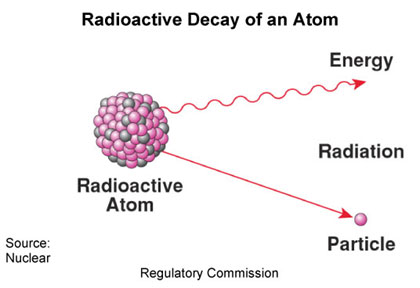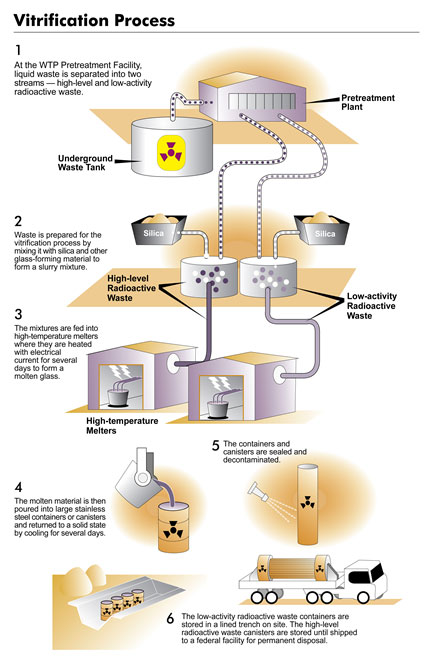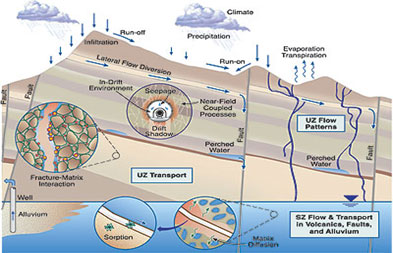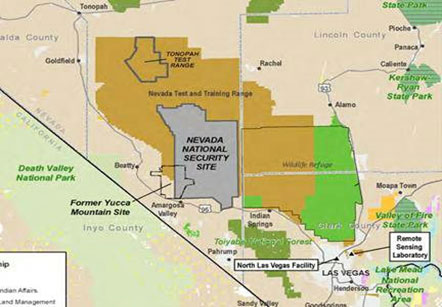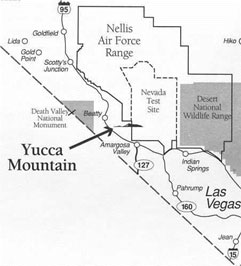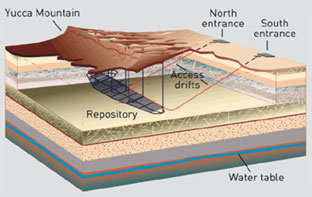Geology and Natural Heritage of the Long Valley Caldera
Research Paper G190: Nuclear Waste
Arielle Soussan
Abstract
Nuclear Waste Disposal has become one of the most prominent controversies in the field of geochemistry due to its impending effects on environmental structures as well as living species. Many nuclear sites or repositories, located in remote areas, consist of unique systems designed to contain or expel the waste. At this point in time, specialists are attempting to devise alternative solutions due to the consequences of nuclear exposure on the populace. A growing concern has been the lasting degree of toxicity in many of the materials that compromise nuclear waste. Research conducted by field scientists from the 1980s to today aims to examine the structures of the microscopic fragments that constitute waste in order to lessen its harmful components. Another field of study has been devoted to understanding the interactions between waste and the landforms in which it’s contained in order to strengthen the natural mechanisms that already seem to be altering the constitution of waste itself for the better. This paper will explore the basic elements that structure waste, as well as the repositories that contain it, then focus upon the case study of the Nevada Test Site, where nuclear weapon testing was conducted for a few decades, as well as Yucca Mountain, also in Nevada, which was a source of unrest due to its status as a potential nuclear waste repository.
Introduction
Nuclear waste is defined as spent fuel after it has been transformed in a reactor. Prior to this process, the fuel was composed of uranium or sometimes thorium, oxygen and steel, and this material is then turned into isotopes due to the decomposition of the uranium atoms. Due to the uranium, this waste is dangerously radioactive. This radioactivity is emitted by volatile atoms known as radionuclides. A radionuclide is in essence an unstable nucleus, and is the product of a process entitled radioactive decay. Gamma rays, consisting of photons, or sub-particles such as alpha or beta particles through the binding of protons and neutrons, are then released into the atmosphere in which they are contained. Radionuclides can either be defined as fission products, the atomic fragments that result from nuclear fission, the process that generates nuclear energy, or actinides, which consist of radioactive metals and release energy following radioactive decay. Fission products typically maintain shorter half-lives, in other words the decay process for half a sample is comparatively minimal, while actinides deteriorate more slowly, and are thus more long-lived. However, the quantity of actinides is more limited.
Illustration: The Inspiring Classroom, posted 2014, from noorahmat.siskg.net
According to Neil A Chapman and Ian G. McKinley in their work: "The Geological Disposal of Nuclear Waste," possibilities for disposal of waste can be divided into two all-encompassing categories: containment, in which waste is held for a certain period of time, and dilute and disperse, which they define as a mindset in which mobilization and transport of waste by natural processes is favored over encasing waste into a set space. Waste conditioning involves the solid compaction of incinerated material, which may release gaseous substances that would then require some form of controlled release. Cementation entails containing waste material in a solid form, at which point the waste is either stored or disposed of. Vitrification is a process that solidifies liquid into borosilicate glass. The waste is then contained into steel containers with the purpose of cooling and storage while the radioactivity levels are minimized over time (a couple thousand years).
Illustration of the process of vitrification from the Department of Ecology, State of Washington
Methods of shallow burial include the creation of trench structures where a drainage system could be installed. A release system could potentially also be implemented that would periodically or constantly release waste. In contrast, a tunnel would be more effective, according to Chapman and McKinley, because the environment around the zone would be preserved. This system, they argue, would also allow for waste release patterns to be more predictable, which would enable the close examination of specialists and give them heightened agency. Chapman and McKinley further propose that isostatic pressing should be applied to some higher activity wastes.
The materials utilized for nuclear waste containment have evolved over time. Chapman and McKinley state that crystalline and ceramic were suggested in 1953, and again by McCarthy in the 1970s. A proposal in 1978 opted for silicate waste, which was later developed into a titanate version that ensures stability of the radioactive content of the waste. Aluminates have been under investigation since the 1990s, and a paper entitled: "The Development of Calcium Aluminate Phosphate Cement For Radioactive Waste Encapsulation" by Paul David Swift published in 2013 assured readers that though progress needed to be made, such as: "to make the crystallization occur during the initial setting and hardening stage," aluminates exhibited the most benefits in comparison to all other materials tested.
In their evaluation of Deep Geological Disposal, Chapman and McKinley define a repository as a structure that should eventually be "vacated, backfilled, sealed, and abandoned." They also asserted that the ideal repository would include a multi-barrier system, some barriers engineered and the final one geological, or environmentally based such as the host rock. This multi-barrier system is designed to sequester waste from the surface and control water flow in order to limit the excessive transportation of harmful substances far distances. A repository is structured through the distinction between the near-field and the far-field. The near-field designates the zone that is most affected by the presence of waste. The near-field also evolves in its composition. As the waste disintegrates, it disassembles into radionuclides, which are then disseminated. As a result, an increase in temperature is observed on the rock edges. The external heat of the waste causes stress to build up due to thermal expansion. A potential result of this process is micro fracturing of the host rock.
Chapman and McKinley isolate the essential elements that need to be considered when selecting the optimal repository are hydraulic conductivity as well as flow paths of the rock mass, which are determined by the host rock structure. They also argue that areas with open fractures should not be candidates for a repository setting due to their seismic nature. As for chemical exposure, release of radioactive contaminants can be lethal. Radioactive energy from waste can be categorized as either high-level or low-level waste. The high-level waste is derived from used fuel sourced from the reactors. In contrast, low-level waste encompasses materials tinged with radioactive energy. They can be found closer to the surface. According to the World Nuclear Organization, high level waste comprises only 3% of the volume of all nuclear waste, however, it contains 95% radioactivity, while intermediate and lower level waste represent 97% of the volume together, and only 5% radioactive content.
Illustration: Interaction between water flow and nuclear energy, from U.S. Department of Energy, Berkeley
The release of waste from the repository can be achieved either through natural causes or human intervention. Human intervention includes the exhumation of a repository, in which the radioactive material would then be uncovered at the surface. Another possibility would be the human decision to alter water flow rates, for example, an increase in flow would then trigger the waste to return to the biosphere more quickly.
Consequences from the exposure to nuclear waste range from pollution to contamination.
The properties of substances that determine their harmful and hazardous potential are ignitibility, corrosivity, reactivity, and toxicity. Waste particularly demands processes of solidification and treatment in order to either reduce or contain these contaminants.
A destructive effect of nuclear waste disposal is contamination of groundwater which can compromise the health of living organisms in the area. Fortunately, climactic events can be included in predictive analysis in order to effectively anticipate damaging consequences in that domain. Another consequence is the circulation of harmful by-products such as gases caused by microbial action stemming from the devolution of organic molecules.
According to Gammage and Berven in their work: "Hazardous Waste Site Investigations Towards Better Decisions," efforts from organizations committed to environmental protection have also implemented restoration programs that aim to "cleanup" nuclear waste sites, minimize waste hazard in the area, and remove debris from the premises. By achieving these goals, they hope to prevent future site decay and limit human exposure to nuclear material. The practice of field sampling is integrated in this process in order to examine effects of exposure on the environmental surroundings. Samples of organic or inorganic pollutants are thus analyzed in order to ascertain the concentration of pollutant distributed throughout the region. Land patterns are also explored in order to take draining into account when attempting to examine land deterioration. A case study conducted on the Nevada Test Site examined levels of radioactivity in the environment around the test area, and concluded that in order to prevent soil contamination, regular maintenance and field calibrations were required. Furthermore, Gammage and Berven asserted that the application of nonintrusive geological methods were now necessary in order to prevent further geophysical deterioration. The miniaturization of geophysical equipment achieved in the past decade maintain the same ability to measure seismic refraction/reflection, electrical resistivity, electromagnetic conductivity, magnetic flux, and finally ground penetration through the use of a radar. The two fields of epidemiology specialized in cancers and birth defects, and toxicology, designed to measure chemical composition and sensitivity, have recently been applied to the study of nuclear waste in order to develop a further understanding of its effects on living species and the environment. For the most part, restoration suffices in preventing disaster, however, many risk assessment regulations are site specific as well as influenced by changing environmental factors, thus the ideal for a nuclear waste facility following testing and use remains a source of ambiguity.
Illustration: Map of the Nevada Test Site, From: "Home, Healing Ourselves and Mother Earth," 2012
The Nevada Test site, now renamed the Nevada National Security Site, is a facility located in the state of Nevada, owned by the US Department of Energy. Originally, the facility was designed to provide a space for nuclear testing by the Department of Defense, and was opened in 1951 following World War 2. Though it occupies a more or less remote area 65 miles northwest of Las Vegas, the closest densely populated area is the Amargosa Valley which lies 88 miles northwest. Nuclear testing was conducted above ground until 1962, then moved underground until testing ceased altogether in 1994. Throughout the active testing period, consequences were reported such as increased incidents of cancer diagnoses in surrounding areas. A mushroom cloud was routinely reported in the 50s by nearby inhabitants. The Nevada Test Site was routinely subject to protests surrounding nuclear weaponry and its associated moral implications. Due to the Partial Test Ban Treaty signed and ratified by the United States as well as many other countries in 1963, further nuclear testing had to be conducted underground due to the explicit restriction on surface and atmospheric testing.
Yucca Mountain in Correspondence To the Nevada Test Site and the Amargosa Valley, University of California Santa Cruz, Environmental Toxicology
Yucca Mountain was a proposed nuclear waste depository located in the Amargosa drainage system. The location of Yucca Mountain was presented as ideal for waste deposit due to the climate of the arid West in terms of the benefits it would offer surrounding containment, more specifically, little to no water would infiltrate or carry the buried waste. Furthermore, the landscape is ideal due to the tuffs which contain minerals that can serve as natural barriers to radionuclide transport in water. According to Broxton, Bish and Warren from the Earth and Space Sciences Division, an asset to Yucca Mountain is its abundance in zeolites, which are microscopic, porous, aluminosilicate minerals, due to the ash-flow tufts in the area. Zeolites provide essential purposes in the nuclear industry due to its unique ability to simultaneously absorb some ions while releasing others, which permanently ensnares and expels fission products. However, according to the report, the efficacy of zeolites in controlling fission products may be reduced when zeolites are heated. Indeed, zeolites found near volcanically altered rock trigger post-eruptive qualities in the water due to the vitric tuffs which are located in the pyroclastic deposits. This would diminish the ability of zeolites to restrain radionuclides in the event of leakage. Calcic clinoptilotites are the most common zeolite at Yucca Mountain, and were said to have accumulated in the unsaturated zone of Yucca Mountain. This formation of calcic clinoptilotites is encouraged by high silica activities. As exemplified in the illustration below, the water table is above 1000 feet, which is impressive considering rock depth.
Illustration, Chemical and Engineering News Magazine
Barriers and containing mechanisms at Yucca Mountain are primarily engineered. According to Chapman and McKinley, a backfill or buffer has been implemented which minimizes the waste’s access to groundwater, as well as alters the chemistry of the groundwater. This device also allows specialists to entrap some radionuclides and thus maintain more agency in oxygen activity. Chapman and McKinley assert that a development to the system of containment has been the phenomenon of: "corrosion resistance," designed to prevent the corrosion of metals. This system utilizes thin layers in order to promote oxidation. The contrasting phenomenon is: "corrosion allowance," which consists in thickening the container in order to keep the substance for a desired lifetime.
Interactions between rock and waste at Yucca Mountain enable various mineral formations and processes of disposal and transportation. For instance, according to Chapman and McKay, crystalline rocks are porous and thus contain many fractures and routes with different orientations for water flow. They also present a unique advantage in that they form at high temperatures, and thus offer thermal stability. This natural phenomenon can control near-field activity and chemistry and prevent significant damage or leakage. Finally, since there are not of significant depths, they can be easily be removed or excavated if need be. Argillaceous rocks, on the other hand, demonstrate thermal instability and are largely immovable without advanced mining machinery and financial support. However, Chapman and McKay argue, due to the fact that argillaceous rocks are stratified due to their sedimentary nature, the length of the flow pathways may be longer and more extensive. Finally, evaporites contain salt and thus function in a stable manner in the environment, as salt serves as a enabler of heat and resists water damage. A potential downside of evaporites, according to Chapman and McKay, are the structuring of instable chemical bonds and the decomposition that occurs at low temperatures. Saline water also tends to flow towards a heat source, which may exacerbate radiation due to heat. An element that is absorbed and ingrained into this complex structure of rock formations is plutonium which Chapman and McKinley claim is of less magnitude in radiological terms, but still releases harmful radionuclides.
Despite these advantages in rock structure, according to the 1989 report: "Nuclear Waste Isolation In the Unsaturated Zone, Focus 1989," air entrapment was observed around matrix blocks. A combination of low matrix permeability as well as the high matrix permeability of the ash-flow tufts has been discovered. The ability of the non-welded matrix chunks lies in its control of infiltration through the subsuming of water through the fractures in the rock. In this system, air may lessen the capability of the matrix to assimilate water through the fractures. The results indicate that air infiltrating the fractures reduces water flow due to the entrapped air occupying space. Effective storage is thus in jeopardy due to the possibility of air entrapment.
Testing and research conducted on site at Yucca Mountain has attempted to predict consequential activity there as well as the effect of potential disposal on geological processes. During the tests at Yucca Mountain, the hydrothermal evolution was observed and manifested in the form of rock temperature, rock masses, changes in rock moisture content, gas pressures, and finally air permeability of fractures. According to the 1989 proceedings report, possible resurgence of volcanic activity in Yucca Mountain was detected through the monitoring of basaltic magma from a mantle source, as well as this hydrothermal monitoring. According to specialists on site, there exists a low probability of a volcanic eruption. According to the proceedings report, this low probability combined with the limited span of consequences for the hypothetical scenarios points to an overall low risk of significant volcanism. However, a flaw to this conclusion is the fact that the inference was made based on past volcanic experiences of the landform. From a seismic standpoint, future faulting of the surface landscape at Yucca Mountain could potentially alter fracture conductivity and potentially augment infiltration rates in terms of water permeation. The effects of a potential seismic event include the rupture of faults in the surrounding areas, deformation of the landscape, and subsequent basaltic volcanism according to the report. In terms of the seismic configuration of the area, the report stated that "no definitive indications of lateral faulting along the north" were discovered, however: "drainage deflections likely indicate left-lateral slip on the northeast...several lines of evidence suggest that lateral deformation would be significant along north-trending faults as well." An inference could thus be made that stress determinators may point to displacement due to the: "oblique extension across north-trending faults." These may be interpreted as characteristics of strike-slip faulting, however, according to field scientists, fault displacement has been reduced all throughout the area past the Solitario Canyon Fault. Faulting affects the exposure to nuclear waste because increased infiltration of chemically altered water containing both tuff and alluvium may transpire along fractures.
Conclusion
In conclusion, Yucca Mountain presents many if not all the advantages of an ideal nuclear waste repository in terms of its location, geological disposition, and geothermal conditions. However, due to backlash from the public in the surrounding area, Yucca Mountain remained a point of contention for quite some time regarding its status. According to the article: "We’re Storing Radioactive Waste Where Now?" by Geoffrey Brumfiel, 75% of residents in Nevada adamantly opposed the project. Finally, due to President Barrack Obama’s disapproval of the site as a repository, "the Department of Energy announced it would withdraw its application for a license to store nuclear waste there" (Brumfiel, Geoffrey. "We’re Storing Radioactive Waste Where Now"). According to Brumfiel, there is a consensus in government to select a new location for deep geological disposal that its inhabitants would approve of. However, Brumfiel argues that there is a legislative bind due to the designation of Yucca Mountain as the U.S.’s site for the nation’s nuclear waste by Congress in 1987. Another complication is the decision of "two states and several utilities" to sue the Nuclear Regulatory Commission on the grounds that they allowed the license to be withdrawn. Brumfiel concludes that the politicians will be required to reach a legislative decision at some point in time, but that time is not anytime soon. Ultimately, the scientific and legislative history of Yucca Mountain demonstrates the complexity of nuclear waste disposal. Though research has offered several mechanisms to contain and secure radioactive waste, these solutions do not sufficiently eliminate the threat of nuclear exposure. Furthermore, the scientific community merely provides objective insight into the functioning of nuclear depositories, and is at the mercy of higher forces such as political figures, governments at the local, state wide, and federal level, as well as residents of adjoining areas. Until a compromise is reached between all parties involved, the status of the disposal of nuclear waste will be in a state of limbo in the sense that no formal decisions have been made, as only proposals are offered, and scientific findings carry little weight in the deliberation and finalization processes.
Works Cited
American Nuclear Society. Nuclear Waste Isolation In the Unsaturated Zone, Focus 1989. 1990. Print.
Broxton, D.E., Bish, D.L., and Warren, R.G., Distribution and Chemistry of Diagenetic Minerals At Yucca Mountain, Nye County, Nevada. Clay Minerals Society. Web. 1987.
Brumfiel, G. We’re Storing Radioactive Waste Where Now? Slate. Web. 2013.
Chapman, N., McKinley, I., and Hill, M. The Geological Disposal of Nuclear Waste. Chichester: J. Wiley. 1987. Print.
Gammage, R. and Berven, B. Hazardous Waste Site Investigations Towards Better Decisions. 1992.
Roland, P. Waste Disposal In Rock. Amsterdam: Elsevier.1994. Print.
Swift, P.D. The Development of Calcium Aluminate Phosphate Cement For Radioactive Waste Encapsulation. 2013. Web.
[Return to Research Projects] [Return to Sierra Home]
